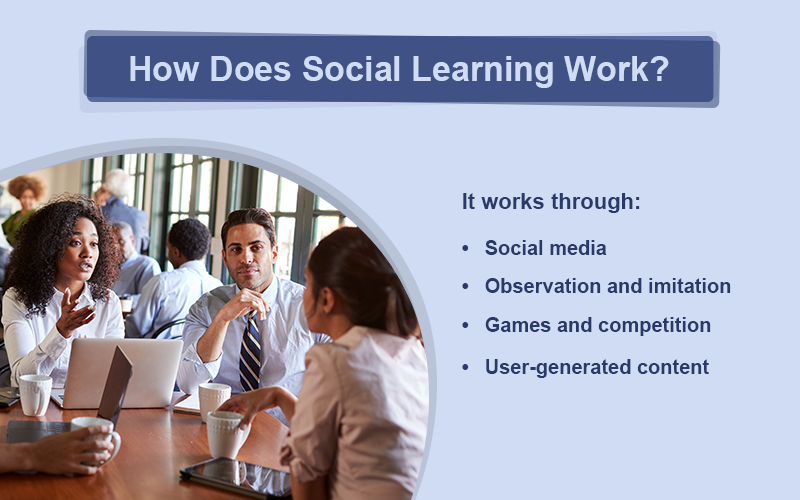Time to Engage the Remote Workforce! Tap into the Power of Social Learning
Social learning is about how people learn by observing, imitating, and modeling others. In this blog, we will see how we can tap into the power of social learning to reach remote workforce.

According to a 2018 Forbes report, around 50% of the U.S. population has already become remote workers. When asked about their biggest workplace challenges, 21% cited “loneliness” or lack of community as one of their main issues. This data reinforces the current global demand for remote friendly workplaces. To address this, organizations are trying to build an online community of learners by leveraging the social learning techniques.
About Social Learning
Advantages of Social Learning
- Keep learners up to date
- Offer round-the-clock support
- Enhance the flexibility of time and space
- Increase the depth of reflection
Ways to Tap into the Power of Social Learning
- Keep your social media groups private
- Create niche, topic-centered online forums
- Develop a remote mentorship program
- Create a user-generated resource library
What Is Social Learning?
The idea of social learning is associated with Albert Bandura’s (1960s) social learning theory of how people learn by observing, imitating, and modeling others. In other words, it is about learning from others and with others. Social learning can either be direct face-to-face learning or an indirect contact through social media platforms. With the advancement of technology, today we have ample opportunities to embed social learning in an online training program. Before looking into those opportunities, let’s see a few advantages social learning can offer in an eLearning program.
Advantages of Social Learning in eLearning
1. Keep learners up to date
When employees are geographically dispersed, it’s difficult for them to stay updated with current industry trends or benefit from the experience and professional expertise of their colleagues. Through social learning, employees can collaborate and communicate limitlessly with their colleagues and thus stay updated with the industry standards, apart from feeling connected.
Using a social media platform or your organization’s learning management portal, employees can share the link to a recently read industry report, YouTube video that helped them tackle a workplace challenge, tips to better performance, and more.
Your organization can also use these platforms to help remote learners feel they are part of a larger group by sharing notifications of upcoming training programs, changing company policies, event reminders, etc.
2. Offer round-the-clock support
Social learning provides remote learners 24/7 access to information, wherever they are. With the help of online platforms, employees can stay connected with industry professionals and employees who have the power to provide advice and just-in-time support to their peers. This platform can also be leveraged to provide remote learners access to subject matter experts and coaches who can guide them on advanced topics.
3. Provide ongoing feedback
In addition to professional advice and tips, social learning also gives employees the opportunity to offer and receive feedbacks from peers. Employees can upload their projects and assessment on the online forum for peer review. Colleagues can recognize strengths and suggest improvements to each other.This social nature of online platforms motivates learners and encourages them to participate actively in online training. It creates a sense of community among employees and makes them feel they are part of something big.
4. Increase the depth of reflection
In comparison to discussions in the classroom where time is limited, in an online environment, learners have the flexibility of time to analyze in-depth and give evidence to support their claims and arguments and have thoughtful and deeper reflections.
3 Tips for Managers to Participate in a Social Learning Approach
Leadership participation is a crucial element for successful social learning, reads a Harvard Business Review report. Employees have to know from their managers that sharing resources or collaborating with peers on social platforms is encouraged in the organization. Following are the three suggestions proposed by the Harvard report for managers to engage remote employees via social channels:
1. Solicit Comments and Feedback from Learners
Make remote employees feel heard with the simple act of listening. Ask them questions such as what their biggest pain points are and what customers tell them. You can also receive employee feedback on new company policies, services and products.
2. Share Relevant Tips, Suggestions, or Accolades for a Task Well Done
Sharing these on a social platform will help learners understand that their managers are paying attention to and recognizing their work.
3. Conduct Meaningful Dialogue with Learners about a Proposed Policy or Solutions
This helps reinforce the idea of collaboration and community building among the remote workforce. Ensure every dialogue is followed by a discussion to tell employees you are serious about the dialogue to make meaningful decisions.
How to Tap into the Power of Social Learning?
1. Keep Your Social Media Groups Private
An open social media group that can be accessed by anybody in the organization might create a feeling of being judged among remote employees. This feeling in fact can make them reluctant to share their personal experiences in a public discussion. Hence, for better employee participation, launch closed social media groups that can be accessed only by the remote employees, their peers, and their immediate managers. This would give employees a better private setting to socialize with peers and open up.
You can get things started with an open-ended enquiry or a poll on a general trend that could break the ice among the remote workforce, who otherwise barely knows each other. This can make everyone feel they are part of a community.
2. Create Niche Topic-Centered Online Forums
Social forums based on an online training topic or the job profile of employees will help them know where to find targeted help quickly. Rather than searching through an entire database of archived posts or FAQs, employees can directly access the niche forum and post their queries to get the information they require on relevant topics.
Have a centralized list so that employees know which forum to visit under each circumstance. For example, if they encounter a software issue, they can access the discussion forum on software troubleshooting.
3. Develop A Remote Mentorship Program
This is an excellent example for social learning among remote workforce. Every employee has their own strengths and weaknesses. In a mentorship program they get an opportunity to benefit from each other’s strong suits and fill their knowledge gaps.
Survey your remote employees to understand their area of expertise and pair them with colleagues who want to hone those abilities. Each mentor can switch into the role of a mentee by pairing up with another employee/mentor who possesses a different skill.
Thus, by focusing on individual employees’ personal areas of improvement, this method helps you provide your remote workforce a learner-centric approach of training. As such, they no more feel they are in an isolated position or deprived of knowledge.
4. Create an User-Generated Resource Library
Encourage employees to develop their own training material and add it to your online training library. This can be a short mobile recorded video where employees share the experience they had with clients, a PPT presentation on negotiation skills to skyrocket sales, or a quick tip sheet to improve task efficiency. These resources can be used by their peers as a ‘moment of need’ support and understand things in a new perspective. This social learning strategy helps make every remote employee feel acknowledged for their unique experience and expertise.
Thus, online social learning gets remote employees involved with a community and helps build new relationships. It provides an opportunity for your remote workforce to express themselves, compete with their peers, discuss in groups, ask questions, receive feedback, and share their expertise through real-time communication, wherever they are.
Organizations are now increasing their focus on social learning and many have also leveraged the power of blended learning to incorporate social learning in their corporate training programs. Would you like to explore the key elements of a blended learning solution? Check this e-book for insights on designing a perfect blended learning solution.





